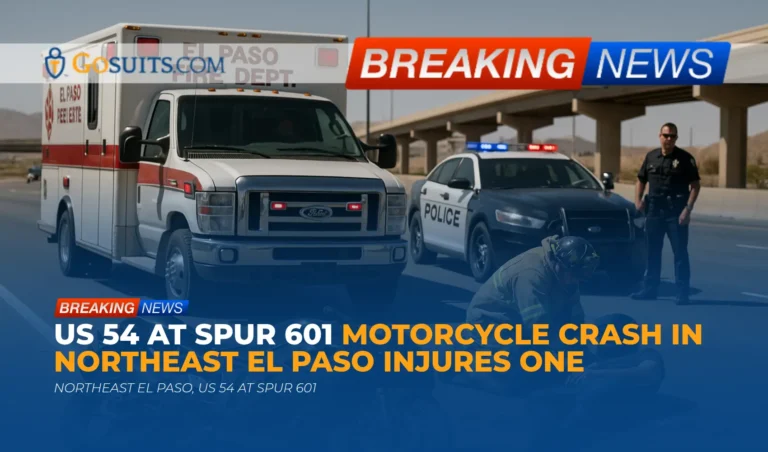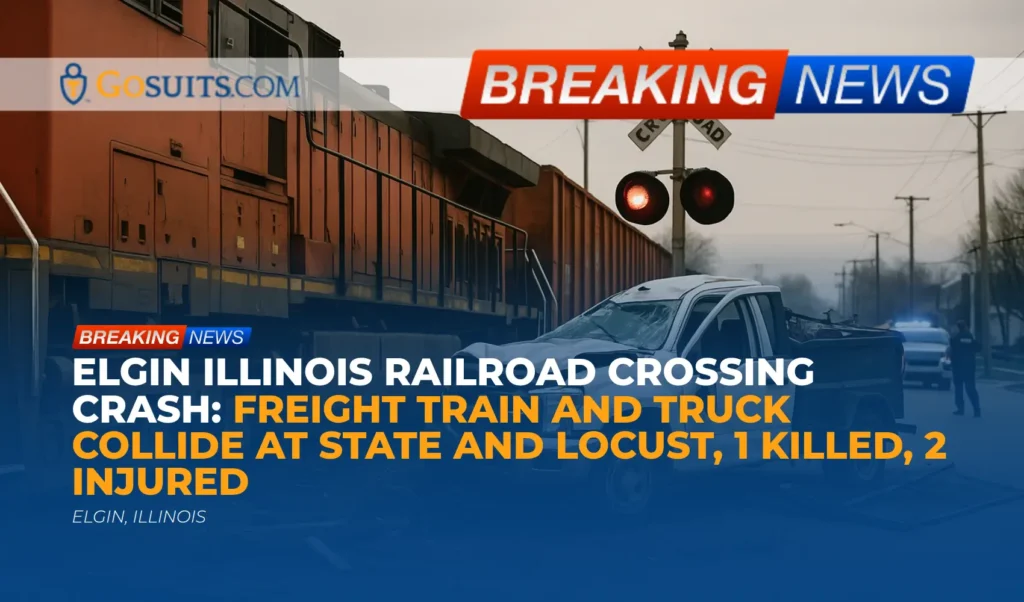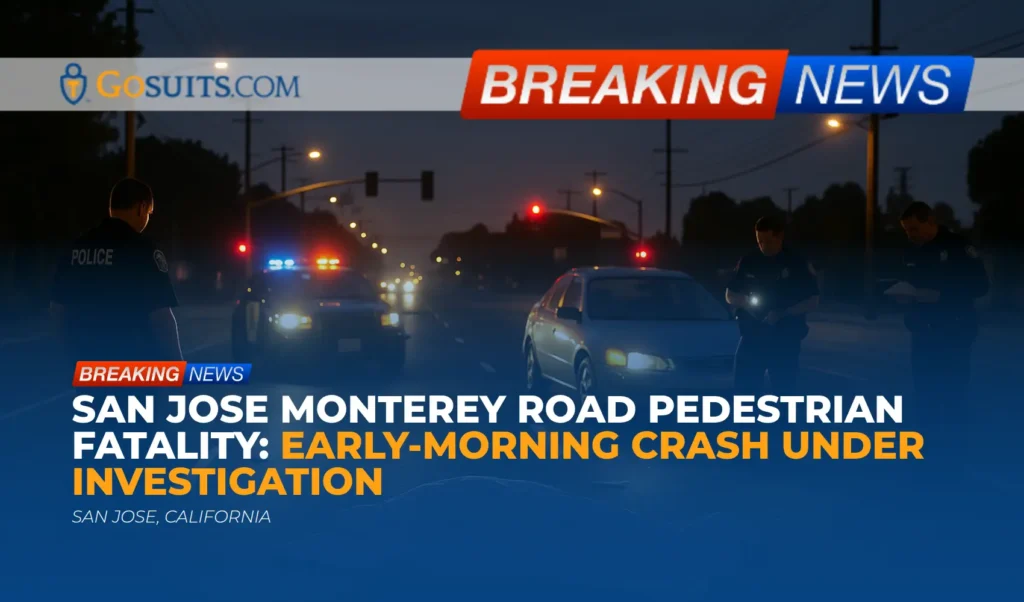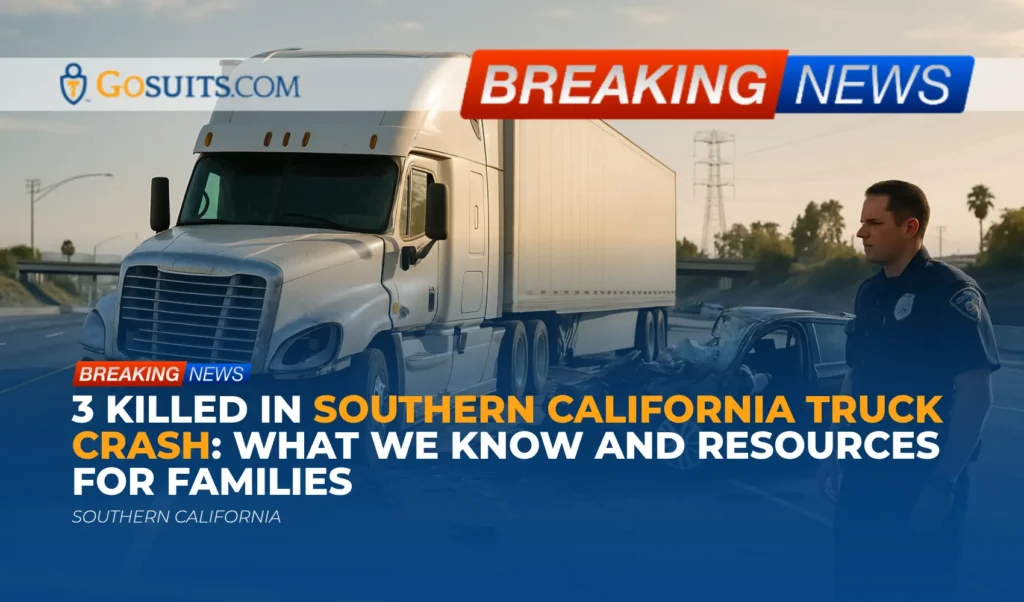- What happened in Northeast El Paso
- Location and timing
- Official response and road closures
- What law enforcement has said so far
- Why motorcycle crashes are often severe
- What factors are commonly investigated in a motorcycle crash
- Texas legal context for roadway crashes
- Records to gather and where to request them
- Insurance considerations after a serious crash
- Time limits and notice requirements in Texas
- Practical next steps after a major crash
- Community and recovery resources
- Call to action: Why acting now matters
- Commentary from Gosuits El Paso, Texas Personal Injury Attorney
What happened in Northeast El Paso
A serious motorcycle crash occurred along US 54 North at the Spur 601 exit in Northeast El Paso. According to initial reports, the incident happened just after 1:37 p.m. on October 18, 2025. Emergency responders from El Paso Fire arrived at the scene, and one individual was transported to a local hospital with serious to life-threatening injuries. Law enforcement officers are conducting an on-site investigation, and traffic lanes were restricted while they worked.
At this time, authorities have not released additional public details such as the cause of the crash, the number of vehicles involved beyond the motorcycle, or the identity of the injured person. This article provides general information to help community members understand the typical process following a serious roadway crash, what records may be available, and how civil liability is usually evaluated in Texas after such incidents.
Location and timing
The crash was reported just after 1:37 p.m. on Saturday, October 18, 2025. The location is US 54 Northbound, near the Spur 601 exit in Northeast El Paso. This interchange is a busy corridor that connects military, commuter, and cross-town traffic. Afternoon conditions often include higher speeds and lane changes as drivers merge for exits, which can elevate risk for motorcyclists if surrounding drivers are inattentive or misjudge distances.
Official response and road closures
Two right lanes and Exit 24B were closed while first responders assisted the injured person and investigators documented the scene. Traffic backups were described as minor, and there was no stated estimate for full clearing at the time of the initial report. When closures occur, it is typically to allow for medical care, scene safety, debris removal, and accurate crash reconstruction.
What law enforcement has said so far
Police remain on scene conducting an investigation. In serious-injury crashes, officers commonly gather physical evidence such as skid or yaw marks, vehicle resting positions, roadway conditions, debris fields, and any potential mechanical defects. They may also collect witness statements and seek out traffic camera footage where available.
In Texas, the crash report for an incident like this is generally submitted to the state’s crash records system. When completed and released, the final “Texas Peace Officer’s Crash Report” often becomes available for purchase through the Texas Department of Transportation’s Crash Records Information System (CRIS). Members of the public can search for and request eligible crash reports at https://cris.dot.state.tx.us/public/Purchase.
Why motorcycle crashes are often severe
Motorcyclists are more vulnerable to severe injury because they lack the protective enclosure, airbags, and crumple zones that passenger vehicles provide. Even at moderate speeds, a direct impact or a secondary slide can cause significant trauma. Nationally, safety agencies have consistently noted that motorcycles represent a disproportionate share of severe and fatal injuries relative to their miles traveled. The National Highway Traffic Safety Administration explains fundamental safety concerns for motorcyclists and offers data-driven guidance on visibility, speed management, and protective gear at https://www.nhtsa.gov/road-safety/motorcycles.
Within Texas, the transportation agency highlights ongoing safety efforts aimed at both riders and drivers, emphasizing the need to look twice, yield appropriately, and refrain from unsafe lane changes. TxDOT’s motorcycle safety initiatives and public awareness campaigns are outlined at https://www.txdot.gov/safety/traffic-safety-campaigns/motorcycle-safety.
What factors are commonly investigated in a motorcycle crash
While the specific cause of the Northeast El Paso crash has not been released, investigators typically consider multiple contributing factors. The following categories are frequently reviewed, using physical evidence, witness accounts, and sometimes event data recorders where applicable:
- Visibility and lookout: Whether surrounding drivers kept a proper lookout before entering, exiting, or changing lanes. Motorcycles are smaller and can be obscured in mirrors or blind spots.
- Speed and lane position: Whether any party was traveling too fast for conditions or making unsafe maneuvers, and how lane positioning might have influenced reaction time.
- Following distance: Whether adequate space was maintained to allow for safe braking and evasive action.
- Failure to yield or improper lane change: Whether a driver merged into the path of a motorcycle or failed to yield the right of way at ramps or exits.
- Impairment or distraction: Whether distraction, fatigue, or impairment played a role.
- Roadway design and conditions: The geometry of the ramp, pavement condition, signage, lighting, and any temporary hazards or debris.
- Mechanical condition: Potential mechanical issues with any involved vehicle, such as brake, tire, or lighting problems.
- Protective equipment: Use of helmets and protective gear. In Texas, helmet use requirements are set by statute, discussed below.
Texas legal context for roadway crashes
Texas follows negligence principles in civil crash cases. Liability is generally determined by whether a driver failed to use ordinary care, and whether that failure caused injury. Fault may be shared among multiple parties. Below are several aspects that often come up after a serious motorcycle crash in Texas. This information is general and educational and not a substitute for tailored legal guidance about any specific situation.
Duties of drivers around motorcyclists
All drivers have a duty to keep a proper lookout, control speed, signal and change lanes safely, and yield the right of way as required. Because motorcycles are smaller and less visible, safe lane changes and accurate distance judgments are critical. TxDOT’s safety materials emphasize looking twice for motorcycles, avoiding distractions, and allowing extra following distance around riders; see TxDOT Motorcycle Safety.
Helmet law and its impact
Texas Transportation Code Chapter 661 addresses helmets. Generally, riders under 21 must wear helmets; riders 21 and older may ride without a helmet if they meet specific criteria such as completion of an approved safety course or adequate health insurance coverage. The statute is available at https://statutes.capitol.texas.gov/Docs/TN/htm/TN.661.htm.
In civil cases, the presence or absence of a helmet may be discussed in relation to injury severity, but fault for the crash itself still turns on the conduct of the involved drivers. Investigators focus on whether each party followed the rules of the road, maintained proper lookout, and acted reasonably under the circumstances.
Comparative fault overview
Texas uses a proportionate responsibility system. If multiple parties share fault, a percentage of responsibility may be assigned to each. Recovery can be reduced by a claimant’s percentage of fault and is barred if a claimant is found more than 50 percent responsible. Allocation of fault is case-specific and depends on the evidence gathered from the scene, witness statements, and expert analysis.
Records to gather and where to request them
Following a serious crash, several records can help families and injured individuals understand what happened and support any insurance claim or civil case. The agencies listed below are typical sources. Links provided are to Texas state or federal government resources.
Police crash report (TxDOT CRIS)
Once the crash report is completed and released, eligible requesters can obtain it through the Texas Department of Transportation’s Crash Records Information System. Many Texas police agencies submit their crash reports to this statewide portal. Access is available at https://cris.dot.state.tx.us/public/Purchase.
Alongside the official report, requesting supplemental materials such as officer narratives, diagrams, or photographs may be possible through the investigating agency’s public information process. Availability can vary based on privacy laws and whether an investigation is still open.
EMS and hospital records
Emergency medical service run sheets, patient care reports, and hospital records document injuries, treatments, and timelines. These are protected health records, and release generally requires the patient’s authorization or a legally recognized representative’s request. The city’s fire department EMS division and the treating hospital’s health information management office typically handle these requests.

Medical examiner and death records
In Texas, deaths that occur in connection with injuries may fall under the jurisdiction of a medical examiner or a justice of the peace, depending on the county. The framework for inquests and medical examiner duties is set out in the Texas Code of Criminal Procedure, Chapter 49, including Article 49.25 on medical examiners, available at https://statutes.capitol.texas.gov/Docs/CR/htm/CR.49.htm.
Certified death certificates are issued by the Texas Department of State Health Services Vital Statistics Section. Information on requesting death records is available at https://www.dshs.texas.gov/vital-records/death-records.
911 audio, dispatch logs, and traffic camera video
Families may request 911 call audio, CAD logs, or related dispatch data from the city’s public safety agencies, subject to exemptions and privacy rules. Some roadway cameras are operated by state transportation agencies; requests for available footage or logs may be directed to the appropriate agency. Responses can depend on retention periods and whether the footage is routinely retained.
Vehicle data, towing, and property records
For vehicles equipped with event data recorders, a qualified professional may be needed to preserve and download data. Towing and storage records can establish chain of custody for the motorcycle and any other vehicles involved. Keeping all damaged gear, including helmets and protective clothing, can be important for later analysis.
Insurance considerations after a serious crash
Insurance coverage often comes from several possible sources. Understanding each and the order in which they might apply can be complicated, especially while medical needs are ongoing. The Texas Department of Insurance offers consumer information about auto coverages and claims at https://www.tdi.texas.gov/consumer/. The points below are general and educational.
At-fault driver liability coverage
Texas requires drivers to carry minimum liability insurance to cover injuries and property damage they cause. In a crash where another driver is negligent, their bodily injury liability insurance may apply to medical expenses, lost income, and other damages, up to policy limits. Serious-injury cases can exceed minimum limits, which is why other coverages may become important.
Uninsured/underinsured motorist, PIP, and MedPay
- Uninsured/Underinsured Motorist (UM/UIM): May provide benefits if the at-fault driver has no insurance or not enough insurance to cover the losses.
- Personal Injury Protection (PIP): In Texas, PIP is often included unless rejected in writing. It can pay for medical expenses and a portion of lost wages regardless of fault.
- Medical Payments (MedPay): Similar to PIP but typically limited to medical bills and with different conditions.
Insurance coverage details vary by policy. The Texas Department of Insurance provides guidance on these coverages and how to initiate claims at https://www.tdi.texas.gov/consumer/.
Property damage claims
Motorcycles and riding gear can be damaged beyond repair in a serious collision. Property damage claims typically cover repair or replacement, diminished value assessments where applicable, and towing/storage fees. Documenting the motorcycle’s pre-crash condition, aftermarket parts, and customizations with photographs and receipts is helpful.
Why to consult an attorney before speaking with insurance companies
Insurance adjusters may quickly request recorded statements or medical authorizations. Statements made early can be used later in ways that are misunderstood or out of context. It is prudent to consult with a lawyer before providing detailed statements or signing broad releases. A consultation can clarify rights, applicable coverages, and the sequence of claims. The Texas Department of Insurance also cautions consumers to document communications and understand what they are consenting to when handling claims; see TDI consumer information.
Time limits and notice requirements in Texas
Texas has strict deadlines for civil actions and certain pre-suit notices. Missing a deadline can limit or bar recovery. The following statutes are provided for general reference.
- General limitations period: Most personal injury claims in Texas must be brought within two years of the date of injury. See Texas Civil Practice and Remedies Code Chapter 16 at https://statutes.capitol.texas.gov/Docs/CP/htm/CP.16.htm (Section 16.003 addresses two-year limitations for personal injury).
- Claims involving governmental units: Special notice requirements apply if a governmental entity may be implicated, such as in a roadway defect or maintenance case. The Texas Tort Claims Act sets a general six-month notice requirement unless a city charter requires earlier notice. See Texas Civil Practice and Remedies Code Chapter 101 at https://statutes.capitol.texas.gov/Docs/CP/htm/CP.101.htm (Section 101.101 addresses notice).
Deadlines can be affected by many factors, including the identity of potential defendants, the age of the injured person, and other statutory provisions.
Practical next steps after a major crash
In the aftermath of a serious collision, it helps to focus on safety and documentation. The following steps are common in Texas cases and are meant to be informative.
- Prioritize medical care: Follow the care plan recommended by medical professionals, attend follow-up appointments, and keep copies of discharge paperwork and prescriptions.
- Preserve evidence: Keep the damaged motorcycle, helmet, jacket, and other gear. Photograph injuries as they heal, the motorcycle, the scene if possible, and any road markings.
- Identify witnesses: Write down names and phone numbers of anyone who saw the crash or stopped at the scene.
- Track expenses and losses: Maintain a file for medical bills, mileage to appointments, time missed from work, and receipts related to the crash.
- Request official records: Obtain the police crash report via TxDOT CRIS when available, and later request EMS/hospital records as needed.
- Consult a personal injury attorney early: Before speaking at length with any insurance company, consider a consultation to understand rights and obligations. What is said to insurers can be used later in ways that affect the outcome.
Community and recovery resources
Recovering from a serious crash is not only physical but also emotional. Supportive services can help. For mental health crisis assistance and connections to local providers, Texas Health and Human Services maintains resources for Texans at https://www.hhs.texas.gov/services/mental-health-substance-use/mental-health-crisis-services. These services can help individuals and families navigate stress, trauma, and recovery planning.
For statewide traffic safety information and educational materials on sharing the road with motorcycles, see TxDOT’s outreach at https://www.txdot.gov/safety/traffic-safety-campaigns/motorcycle-safety. National safety perspectives and data are available from NHTSA at https://www.nhtsa.gov/road-safety/motorcycles.

Call to action: Why acting now matters
This section is intended to help the public understand why timely action can make a difference after a serious roadway crash. It is not directed to any particular individual or family.
- Preserve critical evidence: Skid marks fade, debris is cleared, and electronic data can be overwritten. Acting promptly helps secure photographs, witness statements, and any available camera footage before it is lost.
- Protect the ability to recover losses: Insurance policies have notice requirements, and Texas law imposes deadlines for bringing claims. Early steps can prevent missed time limits and support a complete presentation of damages. See general limitations at Chapter 16, Civil Practice and Remedies Code.
- Avoid missteps with insurers: Recorded statements and broad medical releases can have unintended consequences. Before contacting an insurance company for a claim, it is wise to consult an attorney to understand rights and obligations. Statements given to insurers may be used later in the claims process. Consumer guidance is available from the Texas Department of Insurance at https://www.tdi.texas.gov/consumer/.
- Coordinate medical care and benefits: Timely communication with healthcare providers and a clear record of treatments can support health recovery and ensure that applicable benefits, such as PIP or MedPay, are considered.
- Assess all potential coverages: Serious-injury cases can involve multiple policies, including at-fault liability, UM/UIM, PIP, MedPay, and sometimes umbrella coverage. Early review helps identify every possible source of recovery.
- Address special notice rules: If a governmental unit might be implicated, the Texas Tort Claims Act includes a six-month notice requirement unless local rules are shorter; see Chapter 101, Civil Practice and Remedies Code. Acting early helps meet these requirements.
Commentary from Gosuits El Paso, Texas Personal Injury Attorney
Our hearts are with the person who suffered serious injuries in the Northeast El Paso motorcycle crash and with everyone affected by the disruption it caused. Situations like this are deeply unsettling for families and bystanders alike. This commentary is for educational and general information purposes, meant to shed light on what typically happens after a serious roadway incident and what questions often arise.
Based on the publicly available details, this crash occurred on a busy corridor where merging and exiting traffic can create complex interactions. In our view, careful lane changes, proper lookout, and respecting a motorcycle’s smaller visual profile are essential to preventing tragedies, especially near exit ramps like Spur 601. When a crash results in serious or life-threatening injuries, it signals a strong impact or hazardous secondary events, underscoring why a thorough investigation is so important.
From experience, we often see insurance carriers and, at times, large corporations move quickly to shape the narrative after a crash. Adjusters may ask for recorded statements right away or request sweeping medical authorizations. People dealing with pain and uncertainty may not realize that seemingly simple answers can be used later to minimize or dispute claims. It is common to see arguments that shift focus to visibility or rider behavior while overlooking unlawful lane changes, unsafe following distances, or failures to yield by other drivers. Understanding how liability is established and how coverages interact can help level the playing field.
A free, confidential consultation can be a meaningful step toward clarity. It gives someone a chance to ask questions, understand applicable coverages like UM/UIM and PIP, and learn how evidence is preserved. It also allows for a discussion of time-sensitive requirements, including potential notice rules if a governmental unit is involved. While no one can promise outcomes, an early conversation can help prevent avoidable mistakes and ensure that important records and deadlines are not missed.
Additional references
- Texas Department of Transportation Crash Records Information System (CRIS) crash reports: https://cris.dot.state.tx.us/public/Purchase
- TxDOT Motorcycle Safety campaign materials: https://www.txdot.gov/safety/traffic-safety-campaigns/motorcycle-safety
- NHTSA Motorcycles road safety page: https://www.nhtsa.gov/road-safety/motorcycles
- Texas Transportation Code, Chapter 661 Helmets: https://statutes.capitol.texas.gov/Docs/TN/htm/TN.661.htm
- Texas Civil Practice and Remedies Code, Chapter 16 Limitations: https://statutes.capitol.texas.gov/Docs/CP/htm/CP.16.htm
- Texas Tort Claims Act, Chapter 101 Notice: https://statutes.capitol.texas.gov/Docs/CP/htm/CP.101.htm
- Texas Department of State Health Services, death records: https://www.dshs.texas.gov/vital-records/death-records
- Texas Code of Criminal Procedure, Chapter 49 Inquests and Medical Examiners: https://statutes.capitol.texas.gov/Docs/CR/htm/CR.49.htm
- Texas Department of Insurance consumer information: https://www.tdi.texas.gov/consumer/






